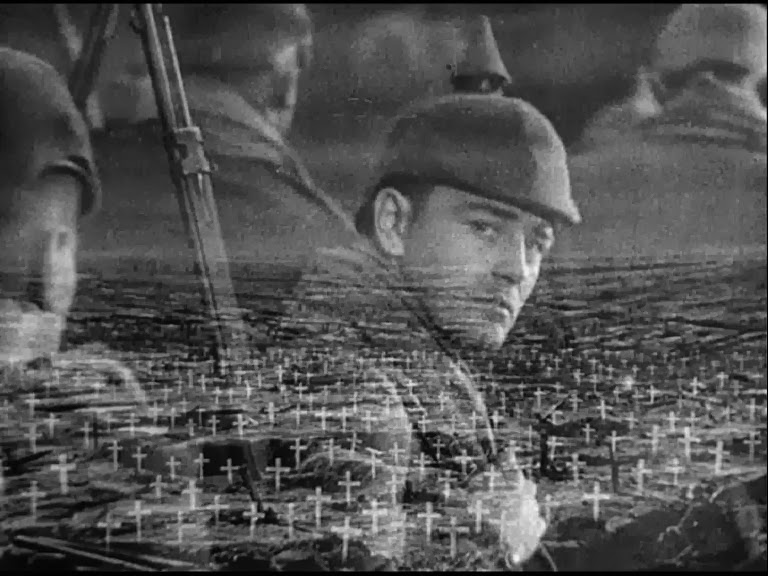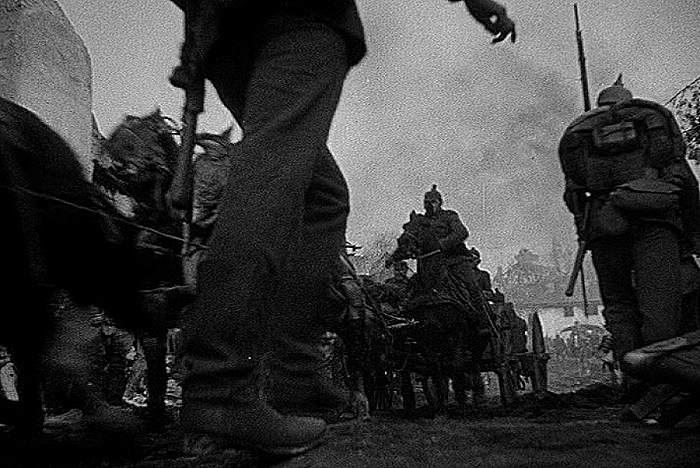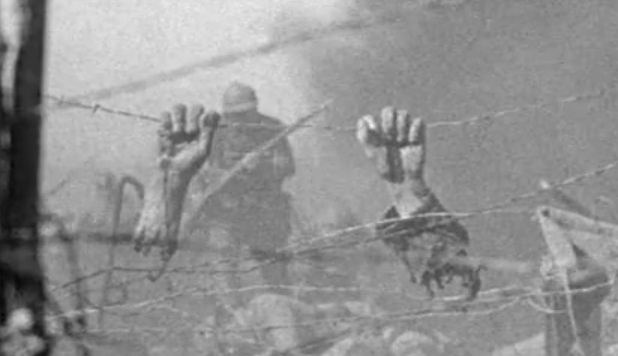All Quiet on the Western Front is a pre-code, black and white, American epic anti-war film released in 1930. Directed by Lewis Milestone, the film revolves around a group of young German schoolboys who are talked into enlisting during the onset of World War I by their extremely patriotic professor. All Quiet on the Western Front focuses on the experience of these young soldiers and the carnage of the war. The film is based on a novel of the same name written by Erich Maria Remarque, a former German soldier who had fought on the Western Front in World War I and had created many works about the horrors of war. All Quiet was released just twelve years after the end of the first world war and was very well received. It won Academy Awards for Outstanding Production and Best Director. Considered a harrowing, realistic account of the first World War, the film was admitted into the Library of Congress’ National Film Registry in 1990.

The wary face of a WWI soldier fades into the shot of the casualties of war
It was considered by some to by anti-militaristic and propagandist. Germany actually banned it because of its perceived anti-German message. However, most critics agree that this is one of the best anti-war films of all time. This film is not about who won or lost. It’s about the horrifying experience of having fought. The narrative and overall meaning of All Quiet is reinforced by realistic, claustrophobic battle scenes, extraordinary sound design that bring those battle scenes to life and heartfelt moments of soldiers dealing with the repercussions of war and loss of their comrades. All Quiet is meant to convey not only the horror of war, but the innocence of those who are fighting in it.
The beginning of the film features a classroom full of young, German men who are eager and excited to go to war and fight for their country. Of all the boys that enlist, Paul, played by Lew Ayres, is the main protagonist of this story. Their excitement is accompanied by an enthusiastic parade going on outside. This enthusiasm is short lived though. Once the boys arrive on the battlefield, everything changes. Their attitudes go from cheerful to horrified and scared rather quickly. Paul sees the people around him get injured, die, starve, and go crazy. You can’t help but feel bad for nearly everyone in this movie and begin to think about the senselessness of war. Although the story is interspersed with lighthearted humor, banter, and drunken debauchery, the moments are bittersweet because you know what ultimately awaits them.

The boys’ early enthusiasm for fighting in the war
There are certain cinematic elements in All Quiet that really add to the overall feel and message of the film. Early in the film there is a large number of low angle shots. These shots portray the soldiers as strong, powerful, and in control. However, as the film progresses we see more high angle shots that depict the soldiers as vulnerable and powerless. The opening scene of the film in which the boys are cheering, raising their fists, excited to fight for their country, is juxtaposed with open windows that show a prideful parade going outside the school, highlighting the early enthusiasm for the war. This is a visual motif that is used several times throughout the film. Doorways and windows acting as a filter between the audience and what’s going on inside the world of war. Lighting is also effectively used to both amplify the drama of and disorient the audience. During the boys’ first night in the bunker, low-key lighting is used to highlight the dramatic intensity of the situation. This is complimented by congested framing (all the subjects are cramped into a small space) and the repetitive sounds of bombings. The sound design for All Quiet may be the most compelling aspect of the film. There is an incessant amount of bombs dropping and exploding sounds. With this, Milestone is able to jar his audience and bombard their senses and emotions. There is no score for the film either. This was done intentionally because they felt it would trivialize the film.

Low angle shot emphasizing the world the soldiers live in

A high angle shot shows the vulnerability of the men in war
Not surprisingly, all the action in this movie takes place on the battlefield. The film does a great job depicting the carnage of the frontline soldiers and those in the trenches. Milestone uses a lot of panning and tracking shots during these battle sequences. One sequence in particular features a German machine gunner in the trench shooting at the charging French soldiers. The camera tracks from left to right, following the gunner’s movement, giving his point of view. This tracking shot is extremely effective because it is able to cover a large amount of space and show the massive number of casualties.

An explosion on set makes the action feel real
The camera also tracks alongside German soldiers as they charge forward, making it feel like you’re right there alongside them. Some of the footage was so real looking that it was actually used in WWI documentaries years later. There is also a large amount of fast cuts throughout these battle scenes. These fast cuts, typical of action films, disorients the viewer. It also sort of puts you in the soldiers shoes, making you hyperaware of everything that is going on but still unaware of what could come next.

An iconic image from the film, of a pair of dismembered hands on barbed wire in “No Mans Land”
In conclusion, All Quiet on the Western Front is about dehumanization and loss of innocence. It’s not about heroism, it’s about surviving and the disillusionment of the war. The film is meant to get audiences thinking about the senselessness of war. It’s a haunting and realistic depiction of what war is like. Not only has it influenced several war films that were made after it, but it also cemented the imagery of the first World War and trench warfare in the minds of all those who have watched it.

Recent Comments